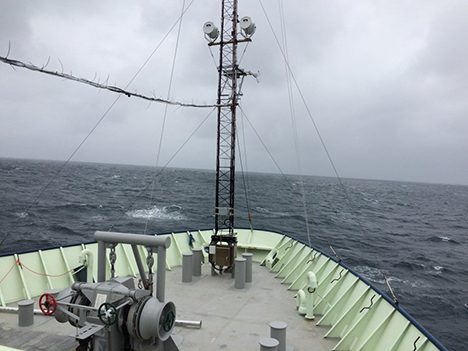The CPC is counting 100 particles/cm3, which is 10 times lower than you normally breathe in room air. We breathe the fresh Atlantic marine air and marine aerosols. The size of particle is less than 500 nm, which is invisible, you can’t even feel it and you can’t take a photo with your iphone. This beautiful day begins with the Ion Efficiency calibration for our instrument high-resolution time-of-flight aerosol mass spectrometer (HR-ToF-AMS) on our transition day. My colleague, Maryam, helped replaced the dryer with her stronger muscles. The selected 300 nm ammonium nitrate particles were generated by atomizer and Differential Mobility Analyzer (DMA) and to calibrate AMS ion efficiency. The flight time of 300 nm ammonium nitrate particles in the ToF vacuum chamber is 0.003 second, which you can image how fast the small particles fly through the 0.295 m pToF chamber. Controlling particle number concentrations with a needle valve is not difficult today makes this calibration went smoothly. A lot of IE calibration and daily data analysis today keeps me busy. Of course, having a cup of coffee and green tea is my everyday drinks.

Maryam is replacing dryer in Russell group’s van. Photo: Chia-Li (Candice) Chen

Bow view when walking outside of aerosol vans.
Every hour in our shift time we check every instrument by VNC remotely monitoring SP2, AMS, Met station, filter switch program, SEMS, OPS, and APS. The largest issue of our AMS instrument is the heater oscillation problem. The AMS heater temperature is set to be 600 degree C when the AMS acquiring ambient data. However, the heater remains fluctuation, manually adjusting it is the easy way for now. Taking apart electronic parts is always the last solution against this issue. The AMS electronic board has mysterious route that connects heater power, transistor, and thermocouple to the tiny vaporizer in the AMS chamber, which only the smart UC Irvine engineer, Cyril, can conquer the difficulty. Fortunately, the AMS has been working well except for the AMS DAQ software bugs problem, AMS monitor replacement yesterday, and one turbo pump died because of over temperature.
The computer lab becomes silent at 2:30 PM since most of scientists are resting for the coming station, only the hiss sound following the movement of ship can be clearly heard.
Single-particle measurement by event trigger mode of AMS is my major work on this ship. What’s event trigger? An event can be a single particle or can be a gas signal event. Even though the Atlantic marine aerosol concentration is low as ~ 1 μg/m3, as long as there are particles existing in the air, which can be measured and triggered by the optimized event trigger levels that was set for which mass-to-charge regions of interest we are looking at. The amazing of this newly developed method is that we can understand more about the external mixing property of single particle. It’s not only single particle with organic chemical composition or sulfate particle suspended in the atmosphere. It could be mixture particle that affects climate change, visibility and phytoplankton in the ocean. The mysterious cycle and relationship of air, ocean, phytoplankton, DMS, VOCs, fine particles, CCN are linked together without breaking any linkages. That’s why we are here.
The food on the ship is so delicious that I can easily gain weight. My favorite food is always seafood… today is blackened Mahi.

My lunch and dinner.
Written by Chia-Li (Candice) Chen



